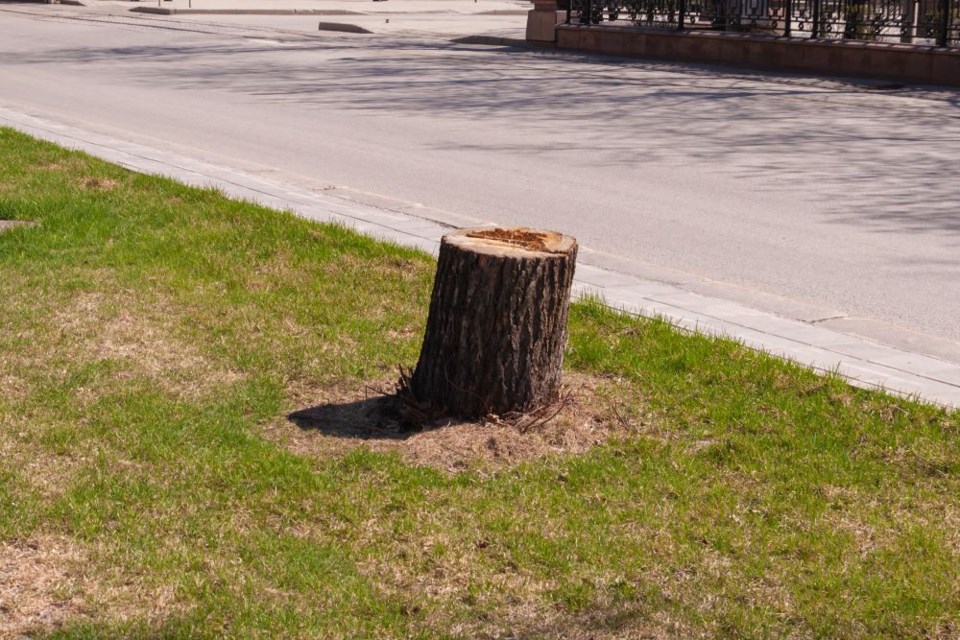As Burnaby makes plans to protect its urban forest, councillors are raising concerns about homebuilders and developers who break bylaws and use loopholes to cut down trees.
Council met to discuss goals for the city’s urban forest strategy July 22.
Three members took aim at builders who flout the city’s tree removal bylaws.
Mayor Mike Hurley said he’s seen “a lot” of builders who plant replacement trees as required by the bylaws only to cut them down shortly after.
“They are enforced to put trees on new homes, but as soon as that final permit is passed, they cut the trees down,” he said. “And that’s just reality, just about everywhere.”
Hurley said the current city policy isn’t working because staff don’t go back to check if the replacement trees have been cut down.
“And I can guarantee you that … within three months, they’re all cut down.”
The city requires a $941 “tree bond” as a security deposit before it issues a tree-cutting permit, and a city arborist has to inspect replacement trees when they are planted and one year later, according to the city’s tree bylaw FAQ.
The bond is refunded if the tree is healthy at the one-year mark.
Coun. Pietro Calendino said there are still “many residents” who don’t like big trees in their yards.
“They take the initiative of ordering it to (be) cut down,” Calendino said.
“I have a feeling that most of the time it’s without a permit.”
The city can issue a $500 ticket for trees that are cut down without a permit; more severe penalties between $2,000 and $10,000 can also be assessed.
Coun. Alison Gu asked staff to put safeguards around another loophole.
She said developers are required to put up fencing to protect trees near construction sites, but sometimes roots sit in the way of something they want to build.
“They put that protection in place and then, somehow, in the middle of the night, somebody comes, and that tree has been hacked to the point where it has no chance of survival,” she said.
She said this both destroys an older tree that would have benefited the community and also takes advantage of a rule that says tree removal permit applicants aren’t subject to the same tree replacement requirements if a tree is sick or dying.
Burnaby won’t automatically grant permits to cut down trees, but it normally will issue a permit if the tree is unhealthy or structurally unsound, according to the bylaw FAQ.
'We are on a path to lose trees'
While Burnaby has the second largest tree canopy in the region at 32 per cent, that number has been shrinking.
The city lost almost three per cent between 2014 and 2020, according to data from Metro Vancouver, though the city’s 2023 state of the urban forest report said the canopy cover remained “relatively stable” because growth compensated for loss.
But staff now anticipate losing more canopy cover if the city’s current protections remain in place.
“We are on a path to lose trees,” said Melinda Yong, environmental planner in the parks department.
“To maintain our current canopy, we will already need to plant a lot of trees … if we want to increase our target, we need to plant more trees on top of that.”
She said those trees also need the proper maintenance to survive, noting the benefit from trees comes after they’re about 50 years old.
As the city is now in the midst of drafting an urban forest strategy, staff asked council if Burnaby wants to reach for Meto Vancouver’s regional target of 40 per cent or a “more aspirational” target.
Council was satisfied with a goal of 40 per cent canopy cover.
Hurley said the city would have to reach at least 40 per cent to “make a difference in this planet.”
Gu suggested aiming for a one per cent increase per year to catch up to the canopy loss.
“The only way we’re going to catch up to that is actually aspire to do better, because the status quo – even going slightly above the status quo – will mean that this canopy cover is consistently decreasing.”
But Calendino suggested not all residents are on board with increasing the canopy if it means keeping a big tree in their yard.
He said the younger generation is more “in tune” with the benefits of trees.
“But the older generation is not, and they don’t want to see trees that shed leaves and needles in their gutters, and they want those trees cut,” he said.
He said if the city agreed to all the requests to cut down trees, “we wouldn’t have any canopy at all.”
Coun. James Wang suggested partnering with the two large, private cemeteries in Burnaby, as he said they have the potential to plant many trees.
Staff will draft the urban forest strategy over the summer and return with a report in the fall.





